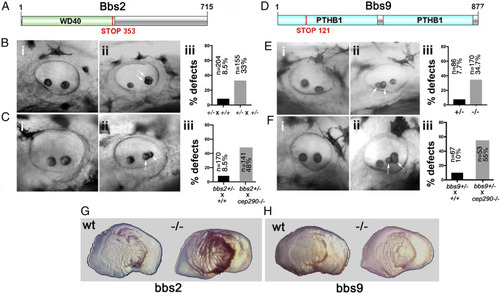Fig. 4
- ID
- ZDB-FIG-230115-56
- Publication
- Leventea et al., 2021 - Ciliopathy genes are required for apical secretion of Cochlin, an otolith crystallization factor
- Other Figures
- All Figure Page
- Back to All Figure Page
|
Otolith phenotypes of BBS mutants and genetic interactions between cep290 and bbs loci at 36 hpf. (A and D) Schematic representation of Bbs2 and Bbs9 protein domain structure. Sites of mutations in bbs2sa2952 and bbs9sa14425 alleles used in this study are indicated. (B), bbs2?/? mutant phenotype. Lateral views of otic vesicles from (i) bbs2+/? outcross to a wild-type strain and (ii) bbs2+/? incross. In (ii) an individual with abnormal otolith morphology is shown. (iii) Frequency of otolith defects in embryos originating from bbs2+/? outcross and incross. (P < 0.0001, ?2 test) (C) Phenotype of embryos originating from bbs2+/? outcrosses to a wild-type and a cep290?/? strain. Lateral views of otic vesicles from (i) bbs2+/? outcross to a wild-type stain and (ii) bbs2+/? outcross to cep290sa1383 homozygous strain. (iii) Frequency of otolith defects in bbs2+/? outcrosses. (P < 0.0001, ? 2 test). (E) Phenotype of bbs9?/? mutant homozygotes. Lateral views of the otic vesicle from (i) bbs9+/? heterozygote and (ii) bbs9?/? mutant homozygote with abnormal otolith number (3 instead of 2). (iii) Frequency of otolith defects in bbs9?/? homozygotes, compared to bbs9+/? heterozygotes (P < 0.0001, x2 test). (F) Phenotype of embryos originating from bbs9+/? outcrosses to a wild-type and a cep290?/? strain. Lateral views of otic vesicles from (i) bbs9+/? outcross to a wild-type and (ii) bbs9+/? outcross to cep290?/? homozygous strain. (iii) Frequency of otolith defects in bbs9+/? outcrosses as above (P < 0.0001, ? 2 test). The arrows indicate abnormally forming otoliths. (G) Examples of cobalt nitrate staining of utricular otoliths from bbs2?/? (H) and bbs9?/? (i) mutants at 23 and 26 mo of age, respectively (n = 3). |
| Fish: | |
|---|---|
| Observed In: | |
| Stage Range: | Prim-25 to Adult |

